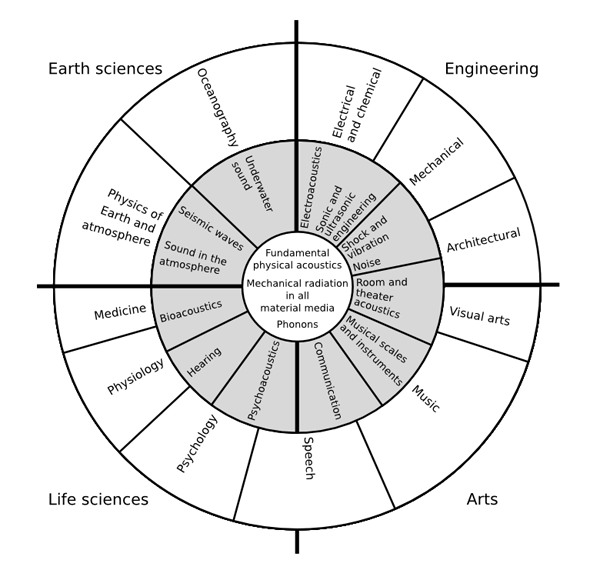Allan Pierce, in his textbook Acoustics: An Introduction to Its Physical Principles and Applications (Acoustical Society of America, New York, 1989), describes the science of acoustics as follows:
“Acoustics is the science of sound, including its production, transmission, and effects. In present usage, the term sound implies not only the phenomena in air responsible for the sensation of hearing but also whatever else is governed by analogous physical principles. Thus, disturbances with frequencies too low (infrasound) or too high (ultrasound) to be heard by a normal person are also regarded as sound. One may speak of underwater sound, sound in solids, or structure-borne sound. Acoustics is distinguished from optics in that sound is mechanical, rather than an electromagnetic, wave motion.
The broad scope of acoustics as an area of interest and endeavor can be ascribed to a variety of reasons. First, there is the ubiquitous nature of mechanical radiation, generated by natural causes and by human activity. Then, there is the existence of the sensation of hearing, of the human vocal ability, of communication via sound, along with the variety of psychological influences sound has on those who hear it. Such areas as speech, music, sound recording and reproduction, telephony, sound reinforcement, audiology, architectural acoustics, and noise control have strong association with the sensation of hearing. That sound is a means of transmitting information, irrespective of our natural ability to hear, is also a significant factor, especially in underwater acoustics. A variety of applications, in basic research and in technology, exploit the fact that the transmission of sound is affected by, and consequently gives information concerning, the medium through which it passes and intervening bodies and inhomogeneities. The physical effects of sound on substances and bodies with which it interacts present other areas of concern and of technical application.
Some indication of the scope of acoustics and of the disciplines with which it is associated can be found in the figure [adapted from R. B. Lindsay, J. Acoust. Soc. Am. 36, 2242 (1964)]. The first annular ring depicts the traditional subdivisions of acoustics, and the outer ring names technical and artistic fields to which acoustics may be applied.”
Information about the various fields of acoustics may be found on the websites of the Technical Committees in the Acoustical Society of America:
- Acoustical Oceanography
- Animal Bioacoustics
- Architectural Acoustics
- Biomedical Acoustics
- Engineering Acoustics
- Musical Acoustics
- Noise
- Physical Acoustics
- Psychological and Physiological Acoustics
- Signal Processing in Acoustics
- Speech Communication
- Structural Acoustics and Vibration
- Underwater Acoustics
